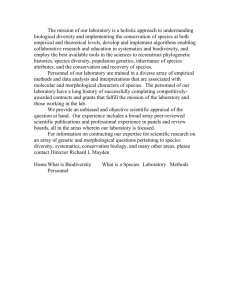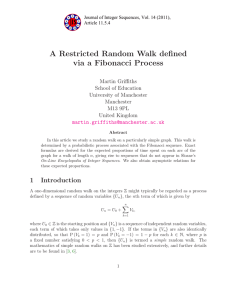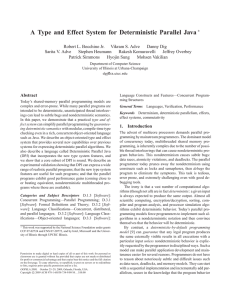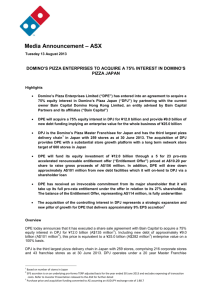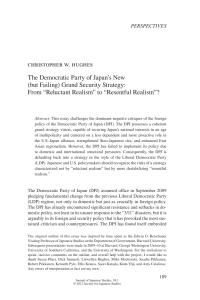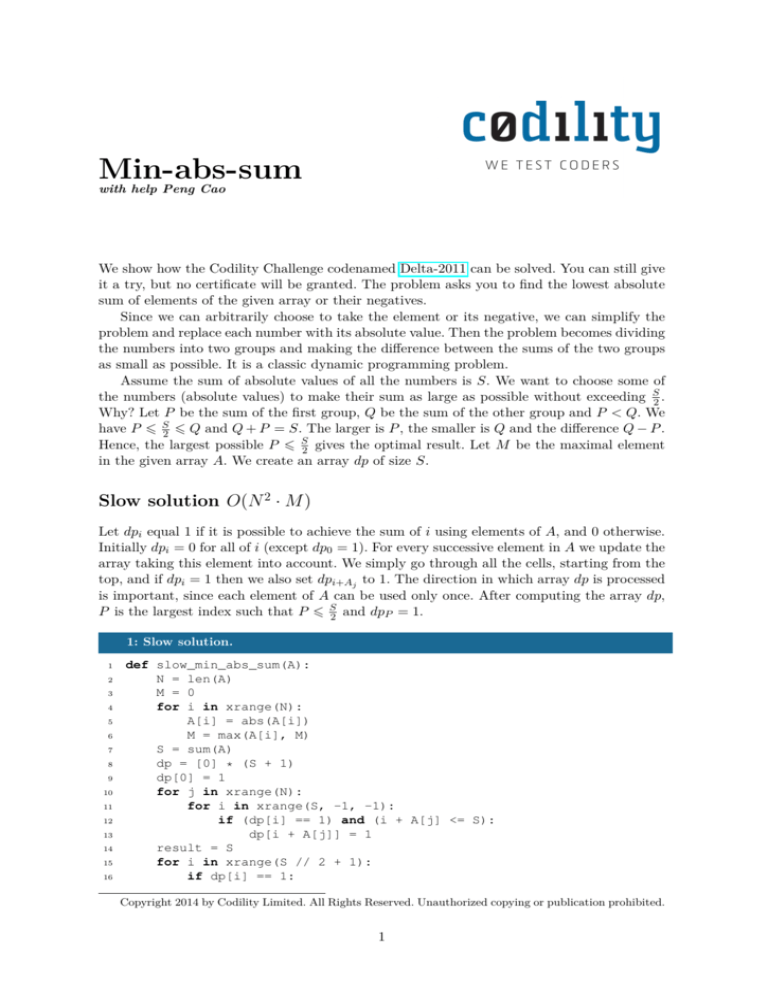
Min-abs-sum
with help Peng Cao
We show how the Codility Challenge codenamed Delta-2011 can be solved. You can still give
it a try, but no certificate will be granted. The problem asks you to find the lowest absolute
sum of elements of the given array or their negatives.
Since we can arbitrarily choose to take the element or its negative, we can simplify the
problem and replace each number with its absolute value. Then the problem becomes dividing
the numbers into two groups and making the difference between the sums of the two groups
as small as possible. It is a classic dynamic programming problem.
Assume the sum of absolute values of all the numbers is S. We want to choose some of
the numbers (absolute values) to make their sum as large as possible without exceeding S2 .
Why? Let P be the sum of the first group, Q be the sum of the other group and P < Q. We
have P ¬ S2 ¬ Q and Q + P = S. The larger is P , the smaller is Q and the difference Q − P .
Hence, the largest possible P ¬ S2 gives the optimal result. Let M be the maximal element
in the given array A. We create an array dp of size S.
Slow solution O(N 2 · M )
Let dpi equal 1 if it is possible to achieve the sum of i using elements of A, and 0 otherwise.
Initially dpi = 0 for all of i (except dp0 = 1). For every successive element in A we update the
array taking this element into account. We simply go through all the cells, starting from the
top, and if dpi = 1 then we also set dpi+Aj to 1. The direction in which array dp is processed
is important, since each element of A can be used only once. After computing the array dp,
P is the largest index such that P ¬ S2 and dpP = 1.
1: Slow solution.
1
2
3
4
5
6
7
8
9
10
11
12
13
14
15
16
def slow_min_abs_sum(A):
N = len(A)
M = 0
for i in xrange(N):
A[i] = abs(A[i])
M = max(A[i], M)
S = sum(A)
dp = [0] * (S + 1)
dp[0] = 1
for j in xrange(N):
for i in xrange(S, -1, -1):
if (dp[i] == 1) and (i + A[j] <= S):
dp[i + A[j]] = 1
result = S
for i in xrange(S // 2 + 1):
if dp[i] == 1:
Copyright 2014 by Codility Limited. All Rights Reserved. Unauthorized copying or publication prohibited.
1
17
18
result = min(result, S - 2 * i)
return result
The time complexity of the above solution is O(N 2 · M ), since S = O(N · M ).
Golden solution O(N · M 2 )
Notice that the range of numbers is quite small (maximum 100). Hence, there must be a lot
of duplicated numbers. Let counti denote the number of occurrences of the value i. We can
improve the previous solution by processing all occurrences of the same value at once. First
we calculate values counti . Then we create array dp such that:
• dpj = −1 if we cannot get the sum j,
• dpj ­ 0 if we can get sum j.
Initially, dpj = −1 for all of j (except dp0 = 0). Then we scan through all the values appearing
in A; we consider all a such that counta > 0.
For every such a we update dp that dpj denotes how many values a remain (maximally)
after achieving sum j. Note that if the previous value at dpj ­ 0 then we can set dpj = counta
as no value a is needed to obtain the sum j. Otherwise we must obtain sum j − a first and
then use a number a to get sum j. In such a situation dpj = dpj−a − 1.
Using this algorithm, we can mark all the sum values and choose the best one (closest to
half of S).
2: Golden solution.
1
2
3
4
5
6
7
8
9
10
11
12
13
14
15
16
17
18
19
20
21
22
23
24
def golden_min_abs_sum(A):
N = len(A)
M = 0
for i in xrange(N):
A[i] = abs(A[i])
M = max(A[i], M)
S = sum(A)
count = [0] * (M + 1)
for i in xrange(N):
count[A[i]] += 1
dp = [-1] * (S + 1)
dp[0] = 0
for a in xrange(1, M + 1):
if count[a] > 0:
for j in xrange(S):
if dp[j] >= 0:
dp[j] = count[a]
elif (j >= a and dp[j - a] > 0):
dp[j] = dp[j - a] - 1
result = S
for i in xrange(S // 2 + 1):
if dp[i] >= 0:
result = min(result, S - 2 * i)
return result
The time complexity of the above solution is O(N · M 2 ), where M is the maximal element,
since S = O(N · M ) and there are at most M different values in A.
Every lesson will provide you with programming tasks at http://codility.com/train.
2




